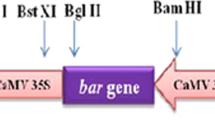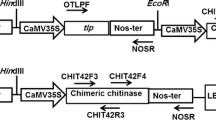Abstract
Rapeseed (Brassica napus L.) is one of the most important economic crops worldwide, and Sclerotinia sclerotiorum is the most dangerous disease that affects its yield greatly. Lipid transfer protein (LTP) has broad-spectrum anti-bacterial and fungal activities. In this study, B. napus was transformed using Agrobacterium tumefaciens harboring the plasmid-containing LTP gene to study its possible capability of increasing plant’s resistance. First, we optimized the petiole genetic transformation system by adjusting the days of explants, bacterial concentrations, ratio of hormones, and cultivating condition. Second, we obtained 8 positive plants by PGR analysis of T0 generation. The PGR results of T1 generation were positive, indicating that the LTP gene had been integrated into B. napus. Third, T1 transgenic plants inoculated by detached leaves with mycelia of S. sclerotiorum showed better disease resistance than non-transformants. Oxalic acid belongs to secondary metabolites of S. sclerotiorum, and several studies have demonstrated that the resistance of rapeseed to oxalic acid is significantly consistent with its resistance to S. sclerotiorum. The result from the seed germination assay showed that when T1 seeds were exposed to oxalic acid stress, their germination rate was evidently higher than that of non-transformant seeds. In addition, we measured some physiological changes in T1 plants and control plants under oxalic acid stress. The results showed that T1 transgenic plants had lower malondialdehyde (MDA) content, higher super oxide dismutase (SOD), and peroxidase (POD) activities than non-transformants, whereas disease resistance was related to low MDA content and high SOD and POD activities.
Similar content being viewed by others
References
Abdelkader, A.B. and Mazliak, P., Lipid Exchange between Mitochondria, Microsomes and Cytoplasmic Supernatant of Potato or Cauliflower Cells, Eur. J. Biochem., 1970, vol. 15, pp. 250–262.
Thoma, S., Hecht, U., Kippersn, A., et al., Tissue-Specific Expression of a Gene Encoding a Cell Wall-Localized Lipid Transfer Protein from Arabidopsis, Plant Physiol., 1994, vol. 105, pp. 35–45.
Sterk, P., Booij, H., Schellekens, G.A., et al., Cell-Specific Expression of the Carrot EP2 Lipid Transfer Protein Gene, Plant Cell, 1991, vol. 3, pp. 907–921.
Torres, S.S., Godoy, J.A., and Pintor-Toro, J.A., A Probable Lipid Transfer Protein Gene is Induced by NaCl in Stems of Tomato Plants, Plant Mol. Biol., 1992, vol. 18, pp. 749–757.
Molina, A., Segura, A., and García, O.F., Lipid Transfer Proteins (nsLTPs) from Barley and Maize Leaves are Potent Inhibitors of Bacterial and Fungal Plant Pathogens, FEBS Lett., 1993, vol. 316, pp. 119–122.
Kader, J.C., Lipid-Transfer Proteins in Plants, Annu. Rev. Plant Physiol. Plant Mol. Biol., 1996, vol. 47, pp. 627–654.
Carmen, R.M., Aguilar, M.B., Miguel, R.N., et al., Amino Acid Sequence, Biochemical Characterization, and Comparative Modeling of a Nonspecific Lipid Transfer Protein from Amaranthus hypochondriacus, Arch. Biochem. Biophys., 2003, vol. 415, pp. 24–33.
Cheng, H.C., Cheng, P.T., Peng, P., et al., Lipid Binding in Rice Nonspecific Lipid Transfer Protein-1 Complexes from Oryza sativa, Protein Sci., 2004, vol. 13, pp. 2304–2315.
Van Loon, L.C. and van Strien, E.A., The Families of Pathogenesis-Related Proteins, Their Activities, and Comparative Analysis of PR-I Type Proteins, Physiol. Mol. Plant Path., 1999, vol. 55, pp. 85–97.
Segura, A., Moreno, M., and García, O.F., Purification and Antipathogenic Activity of Lipid Transfer Proteins (LTPs) from the Leaves of Arabidopsis and Spinach, FEBS Lett., 1993, vol. 332, pp. 243–246.
Ooi, L.S., Tian, L., Su, M., et al., Isolation, Characterization, Molecular Cloning and Modeling of a New Lipid Transfer Protein with Antiviral and Antiproliferative Activities from Narcissus tazetta, Peptides, 2008, vol. 29, pp. 2101–2109.
Rogozhin, E.A., Odintsova, T.I., Musolyamov, A.K., et al., The Purification and Characterization of a Novel Lipid Transfer Protein from Caryopsis of Barnyard Grass (Echinochloa crusgalli), Appl. Biochem. Microbiol., 2009, vol. 45, pp. 363–368.
Gonorazky, A.G., Regente, M.C., and de la Canal, L., Stress Induction and Antimicrobial Properties of a Lipid Transfer Protein in Germinating Sunflower Seeds, J. Plant Physiol., 2005, vol. 162, pp. 618–624.
Carvalho, A.O., Souza-Filho, G.A., Ferreira, B.S., et al., Cloning and Characterization of a Cowpea Seed Lipid Transfer Protein cDNA: Expression Analysis during Seed Development and under Fungal and Cold Stresses in Seedlings’ Tissues, Plant Physiol. Biochem., 2006, vol. 44, pp. 732–742.
Nishimura, S., Tatano, S., Gomi, K., et al., Chloroplast-Localized Nonspecific Lipid Transfer Protein with Anti-Fungal Activity from Rough Lemon, Physiol. Mol. Plant Path., 2008, vol. 72, pp. 134–140.
Kirubakaran, S.I., Begum, S.M., Ulaganathan, K., et al., Characterization of a New Antifungal Lipid Transfer Protein from Wheat, Plant Physiol. Biochem., 2008, vol. 46, pp. 918–927.
Lee, S.B., Go, Y.S., Bae, H.J., et al., Disruption of Glycosylphosphatidylinositol-Anchored Lipid Transfer Protein Gene Altered Cuticular Lipid Composition, Increased Plastoglobules, and Enhanced Susceptibility to Infection by the Fungal Pathogen Alternaria brassicicola, Plant Physiol., 2009, vol. 150, pp. 42–54.
Sarowar, S., Kim, Y.J., Kim, K.D., et al., Overexpression of Lipid Transfer Protein (LTP) Genes Enhances Resistance to Plant Pathogens and LTP Functions in Long-Distance Systemic Signaling in Tobacco, Plant Cell Rep., 2009, vol. 28, pp. 419–427.
Regente, M.C., Giudici, A.M., Villalan, J., et al., The Cytotoxic Properties of a Plant Lipid Transfer Protein Involve Membrane Permeabilization of Target Cells, Lett. Appl. Microbiol., 2005, vol. 40, pp. 183–189.
Maldonado, A.M., Doerner, P., Dixon, R.A., et al., A Putative Lipid Transfer Protein Involved in Systemic Resistance Signaling in Arabidopsis, Nature, 2002, vol. 419, pp. 399–403.
Buhot, N., Douliez, J.P., Jacquemard, A., et al., A Lipid Transfer Protein Binds to a Receptor Involved in the Control of Plant Defense Responses, FEBS Lett., 2001, vol. 509, pp. 27–30.
Blein, J.P., Coutos-Thévenot, P., Marion, D., et al., From Elicitins to Lipid-Transfer Proteins: A New Insight in Cell Signalling Involved in Plant Defense Mechanisms, Trends Plant Sci., 2002, vol. 7, pp. 293–296.
Girault, T., Francois, J., Rogniaux, H., et al., Exogenous Application of a Lipid Transfer Protein-Jasmonic Acid Complex Induces Protection of Grapevine towards Infection by Botrytis cinerea, Plant Physiol. Biochem., 2008, vol. 46, pp. 140–149.
Roy-Barman, S., Sautter, C., and Chattoo, B.B., Expression of the Lipid Transfer Protein Ace-AMP1 in Transgenic Wheat Enhances Antifungal Activity and Defense Responses, Transgenic Res., 2006, vol. 15, pp. 435–446.
Jayaraj, J. and Punja, Z.K., Combined Expression of Chitinase and Lipid Transfer Protein Genes in Transgenic Carrot Plants Enhances Resistance to Foliar Fungal Pathogens, Plant Cell Rep., 2007, vol. 26, pp. 1539–1546.
Neumanna, G.M., Condron, R., Thomas, I., et al., Purification, Characterization and Sequencing of a Family of Petunia Petal Lipid Transfer Proteins Phosphorylated by Plant Calcium-Dependent Protein Kinase, Plant Sci., 1995, vol. 107, pp. 129–145.
Li, C.B., Cloning of OsLTP1 Gene from the Brazilian Upland Rice cv. IAPAR 9, Its Expression Analysis and Function Identification, Dissertation of IGDB, Chin. Acad. Sci., 2004.
Wu, C.R. and Liu, H.L., Screening Methods for Resistance (Tolerance) to Sclerotinia sclerotiorum in Rape, J. Plant Protect., 1997, vol. 18, pp. 323–327.
Cheng, Z.D., Wei, Z.M., and Xu, Z.H., Transformation of Brassica napus Using Agrobactirum tumefaciens and Regeneration of Transgenic Plants, Plant J., 1994, vol. 36, pp. 657–663.
Wang, Y., Zeng, Y.L., He, B., et al., Research of NHX Gene Transformation in Brassica napus by Agrobacterium tumefaciens, Acta Agron. Sin., 2006, vol. 32, pp. 278–282.
Wang, A.G., Shao, C.B., and Luo, G.H., Research on Malondialdehyde as an Indicator of Lipid Peroxidation, Plant Physiol. Commun., 1986, vol. 22, pp. 55–57.
Zhao, J.W., Xiao, L., He, F.X., et al., Relationship between Some Enzyme Activity and Resistance to Sclerotinia sclerotiorum of New Strain Selected by Intergeneric Hybridization in Brassica napus, Chin. J. Oil Crops Sci., 1998, vol. 20, pp. 38–41.
Xiong, Q.F., Liu, S.Y., and Li, H.S., The Response of Some Enzyme Activities to Oxalic Acid Treatment in Resistant and Susceptible Sclerotinia sclerotiorum Rapeseed Varieties (Brassica napus), J. Huazhong Agric. Univ., 1998, vol. 17, pp. 10–13.
Feng, S.Q., Zhang, Y., Xu, J.W., et al., Activities of Some Defense Enzymes in Brassica napus L. and Their Relations with Resistance to Sclerotinia sclerotiorum, J. Huazhong Agric. Univ., 2005, vol. 24, pp. 231–235.
Author information
Authors and Affiliations
Corresponding author
Additional information
The article is published in the original.
Rights and permissions
About this article
Cite this article
Fan, Y., Du, K., Gao, Y. et al. Transformation of LTP gene into Brassica napus to enhance its resistance to Sclerotinia sclerotiorum . Russ J Genet 49, 380–387 (2013). https://doi.org/10.1134/S1022795413040042
Received:
Published:
Issue Date:
DOI: https://doi.org/10.1134/S1022795413040042




